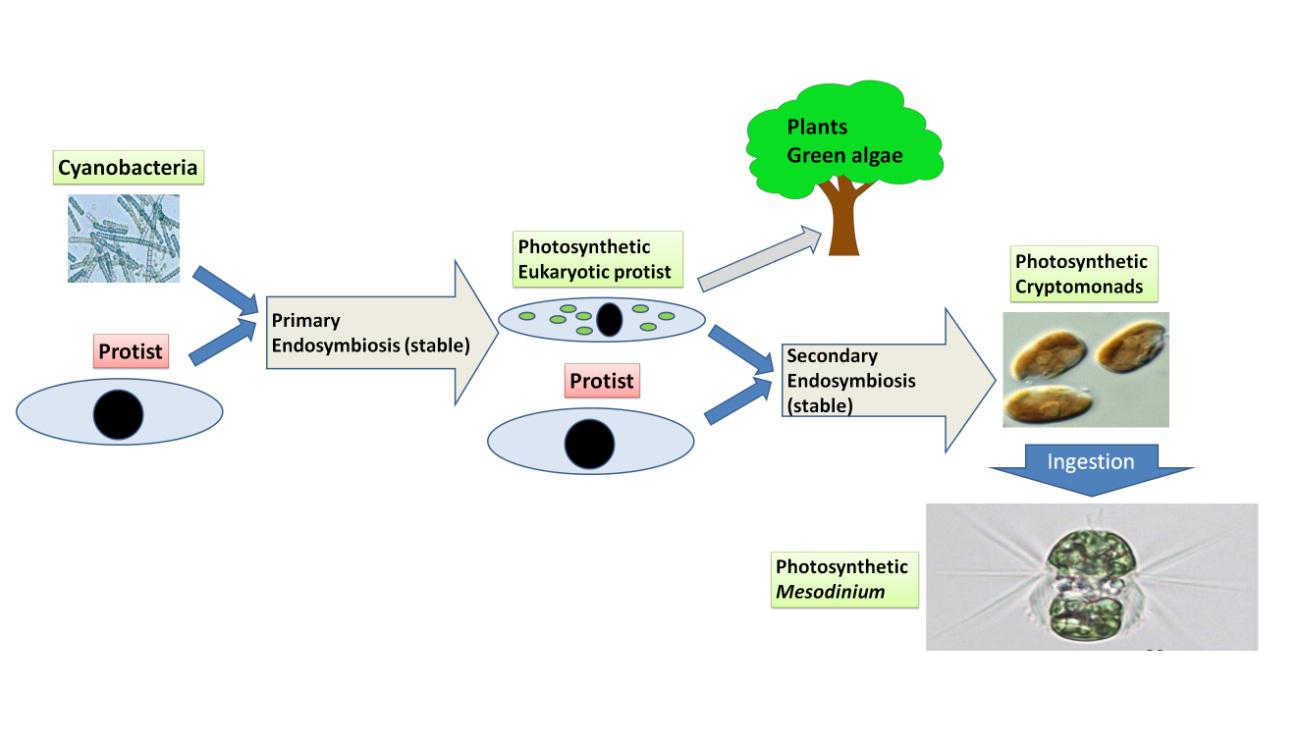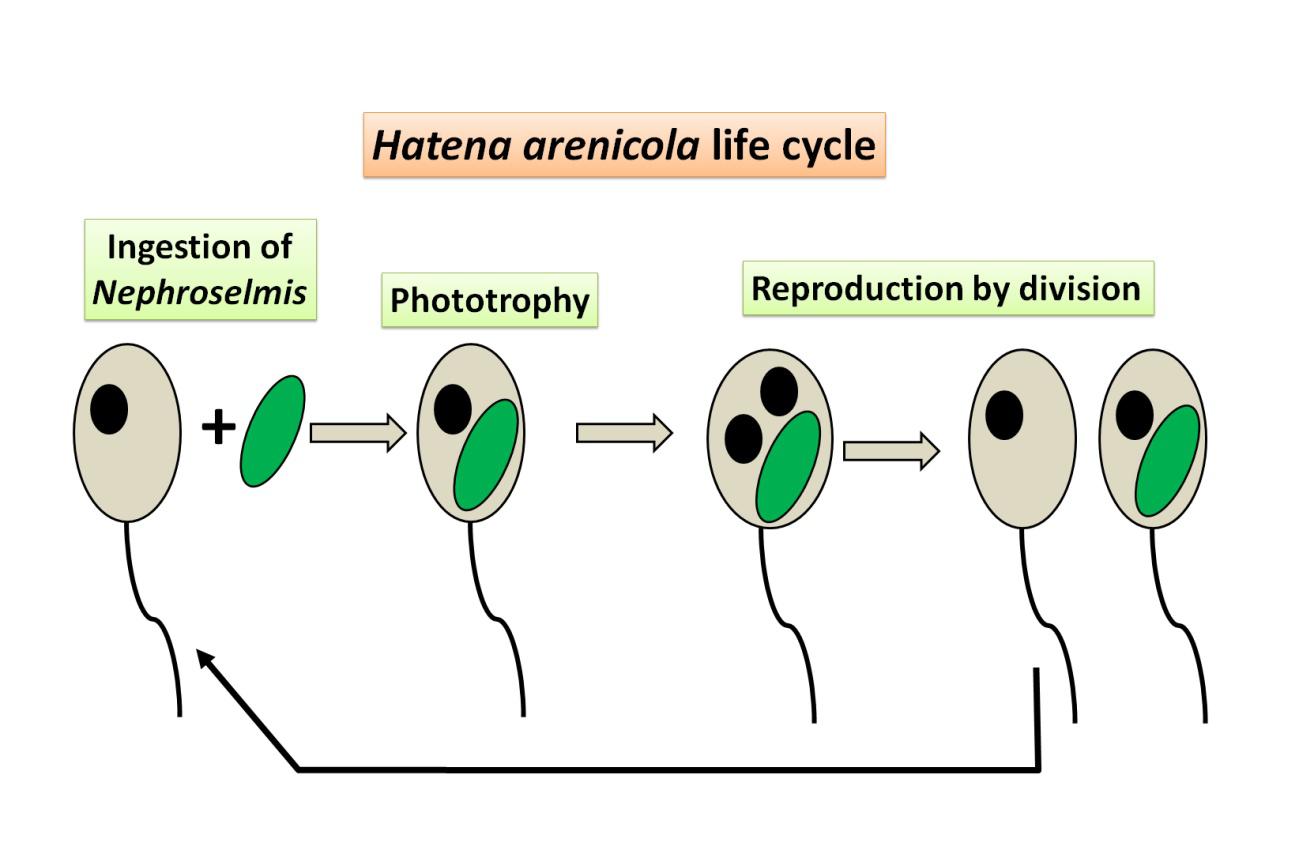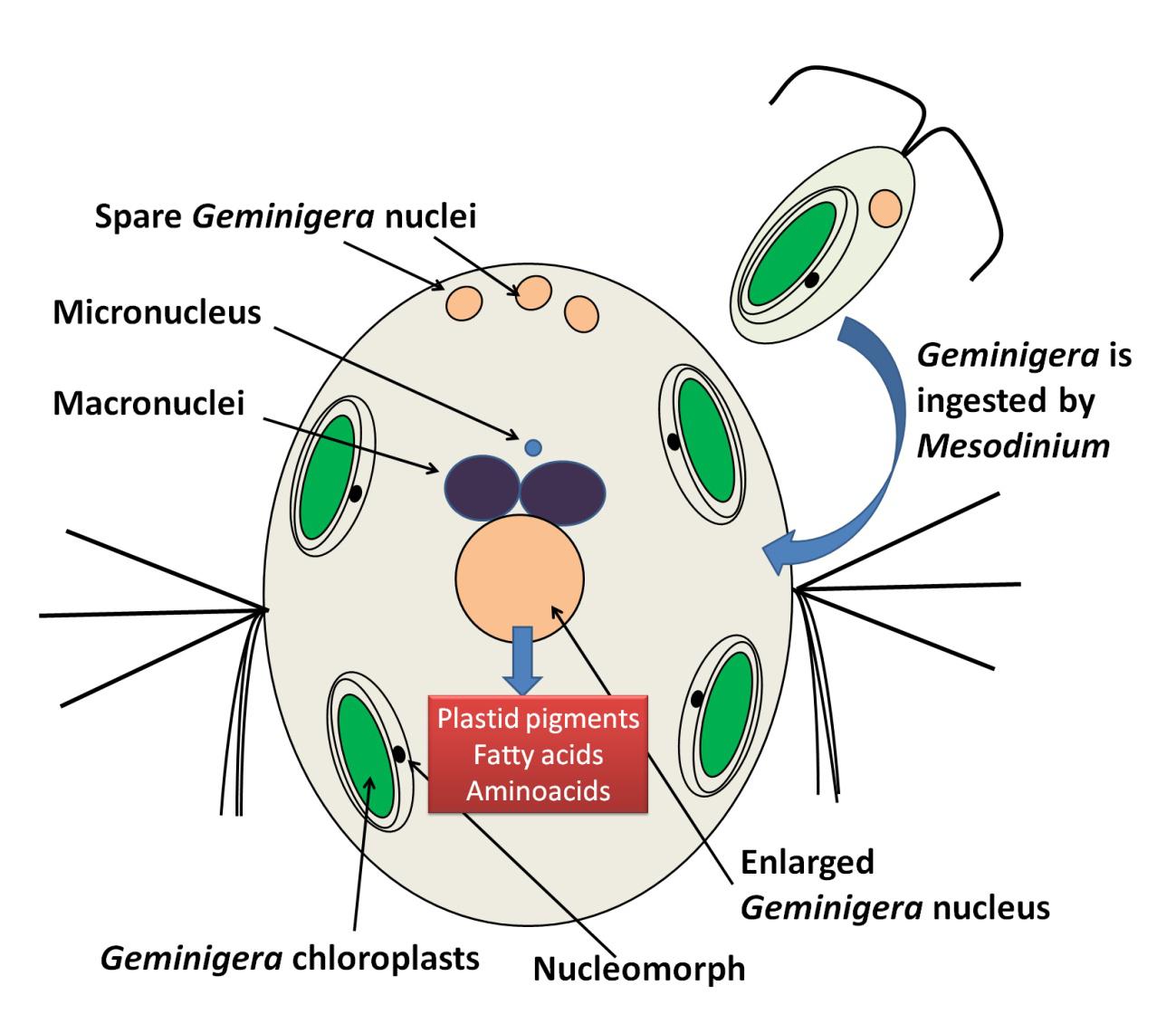Stolen phototrophy and enslaved nuclei: the sophisticated strategy of Mesodinium rubrum
Mesodinium
Author: Ramón Muñoz-Chápuli has been Professor of Animal Biology in the University of Málaga until his retirement. He has investigated for forty years in the fields of developmental biology and animal evolution.
The ciliate Mesodinium rubrum acquires phototrophy by ingestion of a photosynthetic cryptomonad. Besides the stolen plastid (derived from a secondary endosymbiotic event in the cryptomonad evolution) Mesodinium incorporates the cryptomonad nucleus that remains transcriptionally active, and it is essential for the host metabolism. At least seven different genomes within a single cell make Mesodinium one of the most complex and fascinating organisms from the genetic point of view.

The invention of photosynthesis is a major event in the history of life. About 2700 million years ago, a group of cyanobacteria developed molecular systems to synthesize carbohydrates using carbon dioxide, water and light as a source of energy. Photosynthetic oxidation of water released molecular oxygen to the atmosphere, changing forever the history of living beings. Eukaryotic organisms never developed a photosynthetic process by themselves, but they took advantage of the cyanobacterial innovation in many, very different and sometimes fascinating ways. The best known and most popular event was the endosymbiosis that permanently associated cyanobacteria to eukaryotic cells, giving rise to photosynthetic protists containing chloroplasts. Green plants and algae derived from these protists. A more complex process is the permanent endosymbiosis of protists and green or red algae (secondary endosymbiosis). In this case, a vestigial nucleus of the alga may remain within the protist as a nucleomorph.

Phototrophy can also be acquired by protists through non-stable endosymbiosis. Many instances occur within radiolaria, foraminifera, ciliates and dinoflagellates. A fascinating example is the flagellate Hatena arenicola, which ingests the unicellular alga Nephroselmis and becomes photosynthetic. When Hatena divides, only one of the descendents inherits the alga, while the other offspring must feed by depredation and wait for other opportunity to engulf a Nephroselmis.
Probably, the most sophisticated strategy of a protist to acquire phototrophy is that displayed by the ciliate Mesodinium (=Myrionecta), one of the main photosynthetic producers in coastal waters. Poblational blooms of Mesodinium cause red tides, potentially harmful for aquaculture. Mesodinium predates on different cryptomonad protists, mainly Teleaulax, Plagioselmis and Geminigera, which are secondary endosymbionts. The singularity of Mesodinium is that it encapsulates not only the prey plastids (kleptoplastia), but also the nucleus (karyoclepty) and mitochondria 1. The cryptomonad nucleus remains functional, and it even growths and becomes larger than the host nucleus. This stolen nucleus cannot replicate, and it has a relatively short half life (about 10 days). Then, Mesodinium loses its phototrophic metabolism and eventually dies unless it can replace the degenerating nucleus from a spare nucleus, obtained by successive ingestion of preys and kept in a reserve.

Thus, Mesodinium incorporates the plastid (which was permanently incorporated along the cryptomonad evolution by secondary endosymbiosis) and also enslaves a transcriptionally active nucleus from its prey. ¿What is its function? A recent paper published in Current Biology by a team from the Woods Hole Oceanographic Institute has described the function of the enslaved nucleus in an artic strain of Mesodinium rubrum that predates on Geminigera cryophila 2. The study has shown that the Geminigera nucleus controls not only the synthesis of the photosynthetic pigments, as it normally does in normal conditions, but also some essential pathways of the host metabolism, such as aminoacid and fatty acid biosynthesis. Despite the importance of these pathways, the host cannot directly control the transcriptional activity of the enslaved nucleus. However, some degree of regulation in response to light suggests some kind of postranscriptional regulation of the synthesis of the plastid pigments. In fact, the Geminigera nucleus expresses fewer genes than the free Geminigera organism, but at higher levels. The pathways downregulated in the enslaved nucleus are related with cell growth and replication, consistently with the failure to replicate.
Thus, Mesodinium has become dependent on the prey machinery not only for acquiring phototrophy but also for a part of its own metabolism. This is an exceptional case of organelle integration similar to that acquired by eukaryotes, but lacking of a permanent endosymbiosis.
It is also fascinating the high genomic complexity of Mesodinium, probably the highest found in an organism. Mesodinium hosts at least seven genomes in a single cell, two large transcriptionally active nuclei (the proprietary macronucleus and the stolen one), the micronucleus involved in sexual reproduction, the proprietary mitochondrial genome and the Geminigera chloroplast, mitochondrial and nucleomorph genomes. The interrelationships and the control of these genomes raise indeed exciting issues for genetists, physiologists and evolutionary biologists.
References
- Johnson MD, Oldach D, Delwiche CF, Stoecker DK. Retention of transcriptionally active cryptophyte nuclei by the ciliate Myrionecta rubra. Nature. 2007;445(7126):426-8. doi: 10.1038/nature05496. ↩
- Johnson MD, Moeller HV, Paight C, Kellogg RM, McIlvin MR, Saito MA, Lasek-Nesselquist E. Functional control and metabolic integration of stolen organelles in a photosynthetic ciliate. Curr Biol. 2023;33(5):973-980.e5. doi: 10.1016/j.cub.2023.01.027. ↩